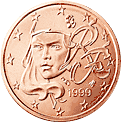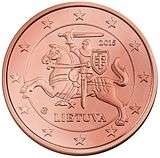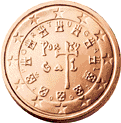2 cent euro coin
| European Union[1] | |
| Value | 0.02 euro |
|---|---|
| Mass | 3.06 g |
| Diameter | 18.75 mm |
| Thickness | 1.67 mm |
| Edge | Smooth with continuous groove |
| Composition | Copper-plated steel |
| Years of minting | Since 1999 |
| Obverse | |
| Design | 24 variations, see below |
| Designer | Various |
| Design date | Various |
| Reverse | |
| Design | Globe with the EU-15 highlighted next to the denomination shown in Latin characters |
| Designer | Luc Luycx |
| Design date | 2002 |
The 2 cent euro coin (€0.02) has a value of one-fiftieth of a euro and is composed of copper-plated steel. All coins have a common reverse and country-specific (national) obverse. The coin has been used since 2002 and was not redesigned in 2007 as were the higher value coins.
History
The coin dates from 2002, when euro coins and banknotes were introduced in the 12 member eurozone and its related territories. Despite this, a few coins were issued beginning in 1999. The common side was designed by Luc Luycx, a Belgian artist who won a Europe-wide competition to design the new coins. The design of the 1 to 5 cent coins was intended to show the European Union's (EU) place in the world (relative to Africa and Asia) as opposed to the one and two euro coins showing the 15 states as one and the 10 to 50 cent coins showing separate EU states.
The national sides, then 15 (eurozone + Monaco, San Marino and the Vatican who could mint their own) were each designed according to national competitions, though to specifications which applied to all coins, such as the requirement of including twelve stars (see euro coins for more). National designs were not allowed to change until the end of 2008, unless a monarch (whose portrait usually appears on the coins) died or abdicated. This happened in Monaco and the Vatican City, resulting in three new designs in circulation (the Vatican had an interim design until the new Pope was selected). National designs have seen some changes due to new rules stating that national designs should include the name of the issuing country (Finland and Belgium both do not show their name, and hence have made minor changes).
As the EU's membership has since expanded (in 2004 and 2007), with further expansions envisaged, the common face of all euro coins from the value of 10 cent and above was redesigned in 2007 to show a new map. The 1 to 5 cent coins, however, did not change, as the highlighting of the old members over the globe was so faint it was not considered worth the cost. But new national coin designs were added in 2007 with the entry of Slovenia, in 2008 with Cyprus and Malta, in 2009 with Slovakia, in 2011 with Estonia, in 2014 with Latvia, and in 2015 with Lithuania.
Design
The coins are composed of copper-covered steel, with a diameter of 18.75 mm, a 1.67 mm thickness and a mass of 3.06 grams. The edges are smooth with a continuous groove running round the coin. This groove helps distinguish the 2 cent coin from the smooth 1 and 5 cent coins, as well as the U.S. penny, which has the same diameter. The coins have been used from 2002, though some are dated 1999 which is the year the euro was created as a currency, but not put into general circulation.
Reverse (common) side
The reverse was designed by Luc Luycx and displays a globe in the bottom right. The then-fifteen members of the EU are lightly highlighted and the northern half of Africa and the western half of Asia (including the Middle East) are shown. Six fine lines cut diagonally behind the globe from each side of the coin and have twelve stars at their ends (reflective of the flag of Europe). To the top left is a large number 2 followed, in smaller text, by the words "Euro Cent". The designer's initials, LL, appear to the right of the globe.
Obverse (national) sides
The obverse side of the coin depends on the issuing country. All have to include twelve stars (in most cases in a circle around the edge), the engraver's initials, and the year of issue. New designs also have to include the name or initials of the issuing country. The side cannot repeat the denomination of the coin unless the issuing country uses an alphabet other than Latin. (Currently this is true only of Greece, which engraves "2 ΛΕΠΤΑ" upon their coins in the Greek alphabet. Austria, which still shows the denomination in German, will have to change its design to comply; see below.)
| Description | Image | |||
|---|---|---|---|---|
| The Austrian design features an Alpine edelweiss as a symbol of Austria's part in developing EU environmental policy. The words "ZWEI EURO CENT" (two euro cent) appear at the top with a hatched Austrian flag below with the date. |
 | |||
| The Belgian design was chosen by a panel of leading Belgian officials, artisans and experts in numismatics. They chose an effigy of King Albert II designed by Jan Alfons Keustermans, Director of the Municipal Academy of Fine Arts of Turnhout. To the right-hand side among the stars was the king's monogram, a letter "A", underneath a crown. The year was lower down, also among the stars. The 2008 redesign included the letters BE (standing for Belgium) beneath the monogram, which was moved out of the stars into the centre circle but still to the right of the King's portrait. The date was also moved out and placed beneath the effigy and included two symbols either side (left: signature mark of the master of the mint, right: mint mark). |
1st Series (2002–2007) |
2nd Series (2008–2013) |
3rd Series (2013-) | |
| The Cypriot design features two Cypriot Mouflon, a species of wild sheep on Cyprus that represents the island's wildlife. It includes, in a semicircle to the top right, the name of Cyprus in Greek and Turkish (ΚΥΠΡΟΣ and KIBRIS) each side of the date. It has been used since Cyprus adopted the euro in 2008. It was chosen in a public vote, and the exact design was created by Erik Maell and Tatiana Soteropoulos. |
||||
| The Estonian design is a design by Lembit Lõhmus and features a geographical image of Estonia and the word “Eesti”, which means “Estonia”. Twelve stars, symbols of the EU, surround the map. This was the winning design in a public vote of ten announced in December 2004. The design started to circulate in 2011.[2] |
||||
| The Finnish design depicts the heraldic lion of Finland found on the Coat of arms of Finland. It is a reproduction of a design by the sculptor Heikki Häiväoja and has been used by previous Finnish coins such as the 1 markka between 1964 and 2001. The first series included the initial of the mint master of the Mint of Finland, Raimo Makkonen (an M), on the bottom left side of the lion and the date to the left. When the coins were redesigned to meet the new design requirements, the initial was replaced by the mint's mint mark and moved to the left, with the letters FI (for Finland) sitting in the bottom right. |
1st Series (2002–2006) |
2nd Series (2007–) | ||
| The French design features Marianne, the feminine representation of France; its state and its values. It is the most prominent representation of France and its ideals of liberty and reason, dating to 1848. The depiction is young and determined, embodying France's desire for a sound and lasting Europe. The letters RF (République française), stylised, appear to the right above the year. The depiction was designed by Fabienne Courtiade of the Paris Mint. |
 | |||
| The German design depicts an oak twig, an image carried over from the previous pfennig. The year and mint mark are shown at the bottom and the image was designed by Professor Rolf Lederbogen. |
 | |||
| The Greek design shows a corvette, a ship used during the Greek War of Independence. Below it is the denomination in Greek and above is the year. It was designed by Georgios Stamatopoulos. |
||||
| The Irish design shows an Irish harp (the Cláirseach, see Celtic harp) used as a national symbol (for example, on the Seal of the President of Ireland). Vertically on the left hand side is the word "Éire" (Ireland in the Irish language) and on the right hand side is the date. The harp motif was designed by Jarlath Hayes. |
||||
| The Italian design is a depiction of the Mole Antonelliana, a museum in Turin completed in 1889 which was originally intended as a synagogue. The interpretation for the coin was engraved by Luciana De Simoni. It includes the interconnected letters RI (Repubblica Italiana) to the left and the year at the right. |
 | |||
| The Lithuanian design is a design by Antanas Žukauskas and features Vytis (symbol of the coat-of-arms) and the word “Lietuva”, which means “Lithuania”. The twelve stars, symbols of the EU, surrounds the Vytis. This was the winning design in a public vote announced in 2004. The design started to circulate in 2015. |
 | |||
| The Luxembourgian design contains a stylised effigy of Grand Duke Henri of Luxembourg designed by Yvette Gastauer-Claire in consultation with the government and monarchy of Luxembourg. The name Lëtzebuerg (Luxembourg in Luxembourgish) and the year are written round the bottom of the coin. |
||||
| The Maltese design depicts an altar at the prehistoric megalith Mnajdra temples. The temples were built in the fourth millennium BCE on the southern coast overlooking the sea. Beneath the depiction is the name Malta and the year. The arms were the third most popular in a public vote and was designed by Noel Galea Bason. It has been used since Malta switched to the euro in 2008. |
||||
| The first Monegasque design contained the coat of arms of Monaco, with the name MONACO written across the top of the coin's outer circle and the year across the bottom of the outer circle with the mint marks. When Prince Albert II succeeded Prince Rainier III in 2005, the overall design was kept but the name and the year were moved within the circle to bring it in line with the new designs of the other coins that had changed significantly. |
1st Series (2002–2005) |
2nd Series (2006–) | ||
| The Dutch design displays a stylised profile of Queen Beatrix of the Netherlands surrounded by the twelve stars and other dots, with the Dutch inscription “beatrix koningin der nederlanden” (Beatrix Queen of The Netherlands) around the edge. The date and mint marks are located at the bottom. Following the accession to the throne of King Willem-Alexander, a new series of euro coins was issued depicting the effigy of the new Head of State. |
||||
| The Portuguese design shows the royal seal of 1134 (stylised "Portugal") surrounded by the country's castles and five escutcheons with silver bezants set in relation to the surrounding European stars, symbolising dialogue, exchange of values and dynamics in the building of Europe. Between the castles are the digits of the year towards the bottom and the letters of the name Portugal between the upper icons. The stars are inset on a ridge. |
 | |||
| The Sammarinese design features the Statue of Liberty on the Palazzo Pubblico. To the left are the words San Marino and to the right, the date. The mint marks are shown to the lower right. |
||||
| The Slovak design depicts Kriváň, a notable peak of the Tatra mountains. Kriváň symbolises Slovakia's sovereignty. Below is the name SLOVENSKO (Slovakia), then the year and the coat of arms of Slovakia with the mint marks either side. The coin came into use in 2009 when Slovakia adopted the euro and it was designed by Ján Černaj and Pavol Károly, chosen by a public competition and vote in 2005. |
||||
| The Slovenian design depicts the Prince's Stone, a reversed ancient Ionic column which was used in the inauguration ceremonies of Karantanian princes in the Early Middle Ages, symbolic of the ancient organisation of power in Slovenia. Between the stars round the right hand edge are the letters SLOVENIJA (Slovenia), followed by the date to the lower left. The design came into use in 2007, when Slovenia adopted the euro. It was designed by Miljenko Licul, Maja Licul and Janez Boljka. |
||||
| The Spanish design displays the Obradoiro façade of the Cathedral of Santiago de Compostela, a prime example of Spanish baroque begun in 1667 by Jose del Toro and Domingo de Andrade and completed in the 18th century by Fernando de Casas Novoa. The cathedral, which is primarily romanesque and dates to 1128, is a major pilgrimage destination. The name España (Spain) is shown to the top left and the top left four stars are indented on a raised area, inverting the effect of the rest of the coin. The date is shown to the top right. |
1st Series (1999–2009) |
2nd Series (2010-) | ||
| The Vatican design has changed twice. The first displayed an effigy of Pope John Paul II. The name CITTÀ DEL VATICANO (Vatican City) was written to his left, the date and mint mark below, and the stars grouped together on his right. Following the death of John Paul II in 2005, a new coin was issued during the Sede vacante until a new Pope was chosen. This contained the insignia of the Apostolic Chamber and the coat of arms of the Cardinal Chamberlain. When Pope Benedict XVI was elected, his effigy appeared on the coins, with the name of the city now above his head with the year and mint mark in the middle to his right. After the resignation of Pope Benedict XVI and the election of Pope Francis, a new effigy of Francis appeared on the new series of Vatican euro coins, with the 2 euro cent displaying the portrait of Francis in a left profile. |
1st Series (2002–2005) |
2nd Series (2005–2006) |
3rd Series (2006–2013) |
4th Series (2013-) |
Planned designs
Austria, Germany and Greece will at some point need to update their designs to comply with guidelines requiring them to include the issuing state's name or initial, and to not repeat the denomination of the coin.
In addition, there are several EU states that have not yet adopted the euro. Some of them have already agreed upon their coin designs, but it is not known exactly when they will adopt the currency, and hence these are not yet minted. See Enlargement of the eurozone for expected entry dates of these countries.
Usage
The one and two-cent coins were initially introduced in order to ensure that the introduction of the euro was not used as an excuse by retailers to heavily round up prices. However, due to the cost to business and the mints of maintaining a circulation of low value coins, Belgium, Ireland, Finland and the Netherlands round prices to the nearest five cents (Swedish rounding) for cash payments, producing only a handful of those coins for collectors rather than general circulation.[3] Despite this, the coins are still legal tender and produced outside these states, so if a customer with a one-cent coin minted elsewhere wishes to pay with it, they may.[4]
The Dutch Bank calculated it would save $36 million a year by not using the smaller coins. Other countries such as Germany favoured retaining the coins due to their desire for €1.99 prices, which appear more attractive to the consumer than a €2 price.[4] According to a Eurobarometer survey of EU citizens, Germans are most sceptical about removing the one- and two-cent coins from circulation, but on average there is a majority (58%) for their removal.[5]
Nicknames
In Flemish, the 1, 2 and 5 cent coins have the nickname koper (copper), ros (redhead), roske or rostjes (little redhead) due to their colour.
References
- ↑ Institutions and the Eurozone countries
- ↑ Coins of CIS and Baltic Countries (accessed 17 April 2014)
- ↑ "Save the penny or leave the penny?". CBC News. 10 October 2007.
- 1 2 "Small Change, Big Annoyance in Europe". BusinessWeek. 23 September 2004. Archived from the original on 2007-10-13.
- ↑ "The euro, 4 years after the introduction of the banknotes and coins" (PDF). Eurobarometer. November 2005.
External links
| Wikimedia Commons has media related to Euro coins (2 cents). |
- "National sides: 2 cents". European Central Bank. Retrieved 18 August 2009.